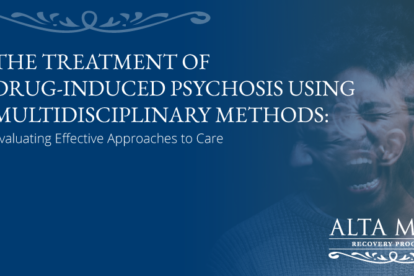
Cannabis-Induced Anxiety Disorder: The Surprising Rise in Diagnoses
Cannabis is one of the most commonly known substances in the world. Research shows that cannabis is taken more often than any other substance in the United States. In 2022, marijuana use among adults ages 19-30 increased to 44% in the United States. The experts at Alta Mira have seen their fair share of cannabis-induced anxiety disorders, especially in younger populations. As leaders in the field of addiction medicine, their goal is to keep researching these topics and share the knowledge with fellow providers.
Understanding the Causes Behind Cannabis Addiction
Marijuana, or cannabis, is made from the seeds, leaves, flowers, and stems of either the cannabis indica or cannabis sativa plant varieties. One key risk factor contributing to the development of a cannabis use disorder is the widespread availability, which facilitates easier access and, consequently, the potential for dependence.
Tetrahydrocannabinol, or THC, is the primary compound responsible for the euphoric sensations associated with cannabis use. Upon consumption, THC is rapidly absorbed into the bloodstream and subsequently distributed throughout the body, including the brain. It is at this stage that the short-term effects of cannabis become apparent. These effects include drowsiness, paranoia, and impaired motor function, highlighting the psychoactive nature of the substance.
Prolonged cannabis use was said to not have any long-term dependence risks, as withdrawal symptoms were not noticed or observed. Recent studies have proven the opposite to be true. Individuals living with cannabis dependence experience aggression, irritability, anxiety, decreased appetite, restlessness, and sleep difficulties during the withdrawal phase. THC has a much longer half-life than other substances, prolonging these symptoms and making withdrawal unrecognizable.
A large-scale study was conducted utilizing data mining from the Australian National Survey of Mental Health and Wellbeing. The study compared DSM-IV and IDC-10 criteria for identifying cannabis-dependent participants. Over 85% matched the criteria of having a cannabis use disorder, and participants also stated they used cannabis to negate withdrawal as well as failing to control their use.

What You Need to Know About Cannabis-Induced Anxiety: Is It Permanent?
Cannabis-induced anxiety disorder can happen short and long-term. When too much cannabis is taken in one sitting, toxicity occurs and results in an increase in anxiety and fear. A study conducted in Michigan showed those entering the emergency department for cannabis toxicity. Of the participants, over 17% reported experiencing anxiety, including panic attacks, manic behavior, and hallucinations. Once the effects of the cannabis faded, these symptoms resolved.
Another study highlighted the long-term effects of regular cannabis use and feelings of anxiety. Participants had been regularly taking cannabis for at least 10 years. The results showed that 21% reported high levels of anxiety. The study also showed teenagers between ages 15 and 16 who had a cannabis dependence were far more likely to develop an anxiety disorder. Cannabis-induced anxiety disorders can be temporary or permanent.
Causes Behind Cannabis-Induced Anxiety
The causes behind cannabis-induced anxiety include variations in environment, genetic factors, frequency and dosing, and anxiogenic response sensitivity. Studies have been conducted involving THC and whole cannabis plant consumption that shows both the human and animal anxiogenic response is increased at higher doses of either substance.
A study collected data to determine the role of stress as a risk factor for using cannabis. It was found that stress-related events including trauma, poor coping skills, and negative life events were drivers behind cannabis use. These findings were most related to chronic use as opposed to experimental. Despite many participants being able to consistently use cannabis without negative consequences, a subset group experienced greater amounts of life stresses, taking cannabis as a coping mechanism. These individuals were more likely to develop a cannabis use disorder and subsequently, higher cases of anxiety.
How to Help Cannabis-Induced Anxiety
Anxiolytic medications are the first choice when helping with acute, cannabis-induced anxiety. Lorazepam is one of the most common, as it is a central nervous system depressant. Though there are other medications in this class, lorazepam provides sedative effects that last up to 24 hours. This provides relief from cannabis-induced anxiety, including panic and psychotic symptoms.
Besides THC, cannabis also contains cannabidiol (CBD). CBD products have gained popularity in recent years as a method for treating anxiety and other neuropsychiatric disorders. These products contain little to no THC, allowing them to produce anxiolytic responses. Studies are being conducted on these methods, and many have shown a positive reduction in anxiety symptoms acutely. Long-term research is needed to determine the continuation of CBD treatments.

Alta Mira Recovery: Co-Occurring Condition Treatment
At Alta Mira Recovery, we acknowledge that successful cannabis addiction treatment requires an approach rooted in clinical precision and empathetic understanding. Our methodology emphasizes the importance of a thorough assessment, including individual psychological, emotional, and behavioral needs. By integrating evidence-based practices with personalized therapeutic interventions, we are dedicated to crafting individualized treatment plans that incorporate a carefully curated blend of psychosocial therapies and pharmacological support to optimize outcomes.
Central to our philosophy is a commitment to treating the whole person, and recognizing the interplay between personal identity, personal life commitments, and spiritual beliefs. Our treatment framework is designed to support these complexities, ensuring each client’s recovery is as holistic as it is effective.
Cannabis-induced anxiety disorder poses cognitive and emotional challenges. Alta Mira’s multidisciplinary team of clinical experts, composed of leaders in addiction medicine and mental health, is adept at addressing these intricacies. By employing a robust, research-driven approach to treatment, we provide the highest standard of care, empowering clients to navigate the recovery process with confidence and regain stability in their lives. Call us today at 866-922-1350 to learn more about our program offerings.
Alta Mira: Science-backed treatment, world-class care.
Sources
“Cannabidiol, a Cannabis sativa constituent, as an anxiolytic drug.” PubMed, https://pubmed.ncbi.nlm.nih.gov/22729452/. Accessed 19 September 2024.
“Cannabis (Marijuana) DrugFacts.” National Institute on Drug Abuse, 24 December 2019, https://nida.nih.gov/publications/drugfacts/cannabis-marijuana. Accessed 19 September 2024.
Crippa, Jose A., et al. “Cannabis and anxiety: a critical review of the evidence.” Wiley InterScience, 19 08 2009, https://flowermed.com.br/wp-content/uploads/2023/01/Cannabis-and-anxiety-a-critical-review-of-the-evidence.pdf.
Hyman, Scott M., and Rajita Sinha. “Stress-Related Factors in Cannabis Use and Misuse: Implications for Prevention and Treatment.” NCBI, https://www.ncbi.nlm.nih.gov/pmc/articles/PMC2696937/. Accessed 19 September 2024.
Jones, Jeffrey S. “Cannabis-Induced Anxiety Disorder in the Emergency Department.” NCBI, 26 April 2023, https://www.ncbi.nlm.nih.gov/pmc/articles/PMC10218760/. Accessed 19 September 2024.
“Marijuana and hallucinogen use, binge drinking reached historic highs among adults 35 to 50 | National Institute on Drug Abuse.” National Institute on Drug Abuse, 17 August 2023, https://nida.nih.gov/news-events/news-releases/2023/08/marijuana-and-hallucinogen-use-binge-drinking-reached-historic-highs-among-adults-35-to-50. Accessed 19 September 2024.
“Marijuana Dependence: Not Just Smoke and Mirrors.” NCBI, https://www.ncbi.nlm.nih.gov/pmc/articles/PMC3606907/. Accessed 19 September 2024.
Sharpe, Lara, et al. “Cannabis, a cause for anxiety? A critical appraisal of the anxiogenic and anxiolytic properties.” Journal of Translational Medicine, 10 2020, https://link.springer.com/article/10.1186/s12967-020-02518-2.






